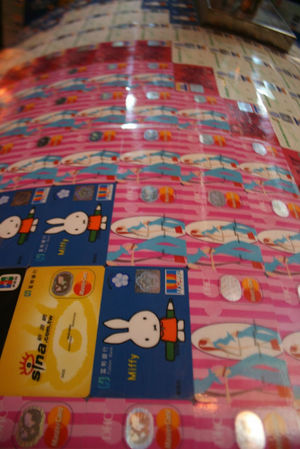Japan/Gallery: Difference between revisions
< Japan
Jump to navigation
Jump to search
imported>John Stephenson (Menu image) |
John Leach (talk | contribs) m (Text replacement - "China" to "China") |
||
| (25 intermediate revisions by 3 users not shown) | |||
| Line 1: | Line 1: | ||
{{subpages | {{subpages}} | ||
<div class="thumb tleft" style="background-color: #f9f9f9; border: 1px solid #CCCCCC; margin:0.5em;"> | <div class="thumb tleft" style="background-color: #f9f9f9; border: 1px solid #CCCCCC; margin:0.5em;"> | ||
{|border="0" cellpadding=" | {|border="0" cellpadding="10" cellspacing="0" style="font-size: 95%; margin: 0.3em;" | ||
|valign=top|[[Image: | |valign=top|[[Image:United_in_different_colors.jpg|300px]] | ||
<div style="border: none; width: | <div style="border: none; width:300px;"><div class="thumbcaption">'[[Cosplay|Cosplayers]]' (from コスプレ ''kosupure'' 'costume roleplay') - teenagers who dress as characters from [[film]], [[television]] or ''[[animé]]'' cartoons - pose for the cameras in [[Harajuku]], [[Tokyo]]. These girls are dressed as members of the Japanese band 'Dir en grey'.<BR><small>Photo © by Sonny Santos, used by [[Image_talk:Menu.jpg/Permission|permission]].</small></div></div> | ||
|valign=top|[[Image:Menu.jpg]] | |valign=top rowspan=2|[[Image:Menu.jpg|350px]] | ||
<div style="border: none; width:350px;"><div class="thumbcaption"> | <div style="border: none; width:350px;"><div class="thumbcaption">This bar menu in [[Shinjuku]], [[Tokyo]] lists food and drink in both angular ''[[katakana]]'' - for [[loanword]]s or to make signs easier to read - and the curvy ''[[hiragana]]'' script - for native [[vocabulary]]. Top of the list, in ''katakana'', is レミーマルタン - ''Remii Marutan'' 'Remy Martin' [[brandy]]; bottom, in ''hiragana'', is あんみつ ''anmitsu'' - a [[jelly]] to finish a meal. The sign on the door (非常口 ''Hijoo Guchi'' 'fire exit') is written in ''[[kanji]]'', or [[Chinese characters|Chinese-derived characters]].<BR><small>Photo © by Sonny Santos, used by [[Image_talk:Menu.jpg/Permission|permission]].</small></div></div> | ||
|- | |- | ||
|valign=top|[[Image: | |valign=top|[[Image:Tokyo_After_Six.jpg|350px]] | ||
<div style="border: none; width: | <div style="border: none; width:300px;"><div class="thumbcaption">Japan's capital, [[Tokyo]], is a city of packed streets, [[neon]] logos and the ancient tucked away alongside the modern.<BR><small>Photo © by Sonny Santos, used by [[Image_talk:Tokyo_After_Six.jpg/Permission|permission]].</small></div></div> | ||
< | |||
|- | |- | ||
|valign=top|[[Image:Japan.gif| | |valign=top rowspan=2|[[Image:Japan.gif|300px]] | ||
<div style="border: none; width:350px;"><div class="thumbcaption"> | <div style="border: none; width:300px;"><div class="thumbcaption">Japan and its neighbours.</div></div> | ||
|valign=top|[[Image:Japan. | |- | ||
<div style="border: none; width:350px;"><div class="thumbcaption"> | |valign=top |[[Image:Harajuku_Up_&_Close.jpg|300px]] | ||
:'' | <div style="border: none; width:350px;"><div class="thumbcaption">Traditional and modern meet on the streets of [[Harajuku]], [[Tokyo]].<BR><small>Photo © by Sonny Santos, used by [[Image_talk:Menu.jpg/Permission|permission]].</small></div></div> | ||
|- | |||
|valign=top|[[Image:A Jesuit Map With Sea of Japan.png|300px]] | |||
<div style="border: none; width:300px;"><div class="thumbcaption">An early seventeenth-century map drawn by an Italian missionary in China. It is the first map in which the name '[[Sea of Japan]]' appears.<BR><small>Image: Public Domain</small></div></div> | |||
|valign=top|[[Image:A British Map With Sea of Japan.jpg|300px]] | |||
<div style="border: none; width:300px;"><div class="thumbcaption">A mid nineteenth-century British map.<BR><small>Image: Public Domain</small></div></div> | |||
|- | |||
|valign=top|[[Image:AKIBA_Scenario.jpg|250px]] | |||
<div style="border: none; width:300px;"><div class="thumbcaption">Promoting a ''maid-kissa'' (メイド喫茶 ''meido-kissa'', 'maid coffee shop') in [[Akihabara]], [[Tokyo]] will involve looking the part; young women in maidlike waitresses' outfits are a common sight in this [[electronics]] quarter of the city.<BR><small>Photo © by Sonny Santos, used by [[Image_talk:AKIBA_Scenario.jpg/Permission|permission]].</small></div></div> | |||
|valign=top|[[Image:Ainu-cise-outside.jpg|350px]] | |||
<div style="border: none; width:300px;"><div class="thumbcaption">Northern Japan is home to the indigenous [[Ainu people]]. A ''cise'' is a traditional Ainu dwelling, with a thatched roof and entranceway separate from the main interior space. These replicas can be seen at [[Nibutani]], an Ainu-majority village in [[Hokkaido]].</div></div> | |||
|- | |||
|valign=top|[[Image:Himeji Castle.jpg|400px]] | |||
<div style="border: none; width:300px;"><div class="thumbcaption">[[Himeji Castle]] is a UNESCO [[World Heritage site]]; its defences and gardens showcase two sides of Japan's history and culture.<br></div></div> | |||
|valign=top| | |||
[[Image:Japanese-cute-bank-cards.jpg|300px]] | |||
<div style="border: none; width:300px;"><div class="thumbcaption">Bank cards with cute characters on them are widely available in Japan. | |||
|- | |||
|valign=top|[[Image:Japanese-restaurant-window.jpg|350px]] | |||
<div style="border: none; width:300px;"><div class="thumbcaption">Japanese restaurants often display plastic replicas of many dishes, so diners can see exactly what to expect.<br></div></div> | |||
|valign=top|[[Image:Japan-prefectures-map.png|350px]] | |||
<div style="border: none; width:300px;"><div class="thumbcaption">Japan's islands are divided into 47 [[Japan/Related_Articles#Prefectures|prefectures]].</div></div> | |||
|- | |||
|valign=top|[[Image:Ryuhei-kawada.jpg|250px]] | |||
<div style="border: none; width:300px;"><div class="thumbcaption">Japanese politician [[Ryuhei Kawada]] campaigning in elections to the [[House of Councillors|upper house]] of the [[Diet of Japan|Japanese parliament]] in 2007; Japan is a [[democracy]] where both [[political party|party]]-affiliates and [[independent (politician)|independents]] such as Kawada can successfully seek office.</div></div> | |||
|valign=top|[[Image:Japanese-doll.jpg|300px]] | |||
<div style="border: none; width:300px;"><div class="thumbcaption">A traditional [[Japanese dolls|Japanese doll]]. The ''Hina Matsuri'' (雛祭り 'Doll Festival') is held every 3rd March in Japan.</div> | |||
</div> | |||
|- | |||
|valign=top|[[Image:tengu-geta.jpg|300px]] | |||
<div style="border: none; width:300px;"><div class="thumbcaption">''Tengu-[[geta]]'' shoes can be seen at traditional festivals.<BR><small>Photo © by Sonny Santos, used by [[Image_talk:tengu-geta.jpg/Permission|permission]].</small></div> | |||
|valign=top|[[Image:Shinjuku-neon Tokyo.jpg|300px]] | |||
<div style="border: none; width:300px;"><div class="thumbcaption">[[Neon]] signs light up the streets of [[Shinjuku]], Tokyo. Logos and other signs often employ the ''[[katakana]]'' script rather than the Chinese-derived ''[[kanji]]'' characters.</div> | |||
</div> | |||
|- | |||
|valign=top|[[Image:Busy Tokyo railway station.jpg|300px]] | |||
<div style="border: none; width:300px;"><div class="thumbcaption">[[Tokyo Station]] commuters.</div> | |||
</div> | |||
<!--|valign=top| | |||
<div style="border: none; width:300px;"><div class="thumbcaption">'''Caption for another photo here.'''</div></div>--> | |||
|- | |||
|align=center|''Return to [[Japan]]'' | |||
|} | |} | ||
{{-}} | |||
Latest revision as of 09:07, 28 February 2024
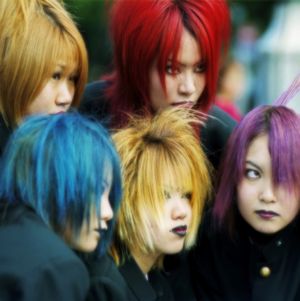
'Cosplayers' (from コスプレ kosupure 'costume roleplay') - teenagers who dress as characters from film, television or animé cartoons - pose for the cameras in Harajuku, Tokyo. These girls are dressed as members of the Japanese band 'Dir en grey'. Photo © by Sonny Santos, used by permission. |
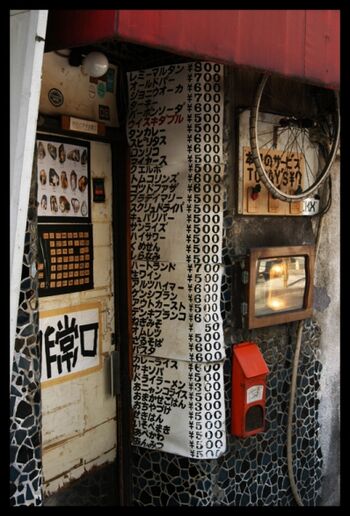
This bar menu in Shinjuku, Tokyo lists food and drink in both angular katakana - for loanwords or to make signs easier to read - and the curvy hiragana script - for native vocabulary. Top of the list, in katakana, is レミーマルタン - Remii Marutan 'Remy Martin' brandy; bottom, in hiragana, is あんみつ anmitsu - a jelly to finish a meal. The sign on the door (非常口 Hijoo Guchi 'fire exit') is written in kanji, or Chinese-derived characters. Photo © by Sonny Santos, used by permission. |
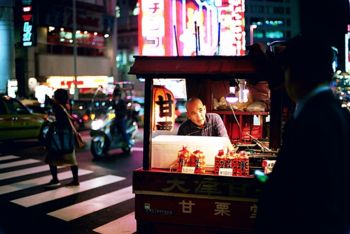
Japan's capital, Tokyo, is a city of packed streets, neon logos and the ancient tucked away alongside the modern. Photo © by Sonny Santos, used by permission. | |
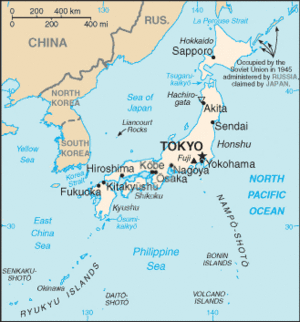
Japan and its neighbours. | |
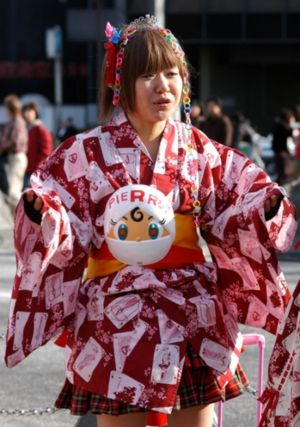
Traditional and modern meet on the streets of Harajuku, Tokyo. Photo © by Sonny Santos, used by permission. | |
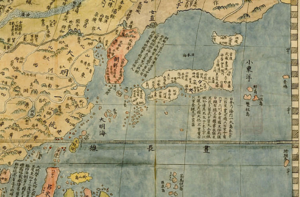
An early seventeenth-century map drawn by an Italian missionary in China. It is the first map in which the name 'Sea of Japan' appears. Image: Public Domain |
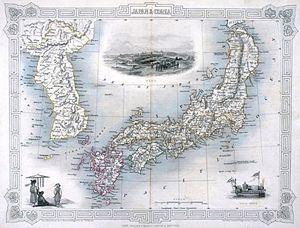
A mid nineteenth-century British map. Image: Public Domain |
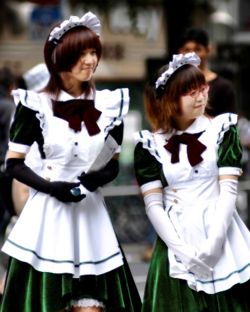
Promoting a maid-kissa (メイド喫茶 meido-kissa, 'maid coffee shop') in Akihabara, Tokyo will involve looking the part; young women in maidlike waitresses' outfits are a common sight in this electronics quarter of the city. Photo © by Sonny Santos, used by permission. |
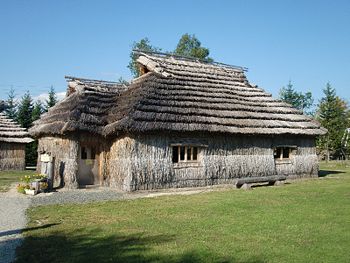
Northern Japan is home to the indigenous Ainu people. A cise is a traditional Ainu dwelling, with a thatched roof and entranceway separate from the main interior space. These replicas can be seen at Nibutani, an Ainu-majority village in Hokkaido. |
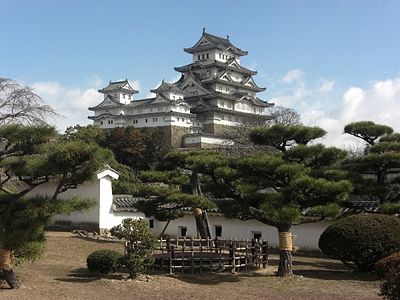
Himeji Castle is a UNESCO World Heritage site; its defences and gardens showcase two sides of Japan's history and culture. |
Bank cards with cute characters on them are widely available in Japan.
|
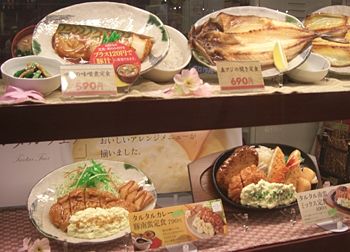
Japanese restaurants often display plastic replicas of many dishes, so diners can see exactly what to expect. |
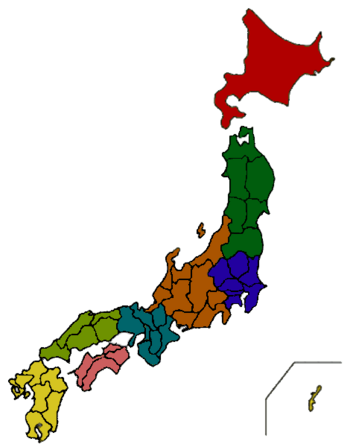
Japan's islands are divided into 47 prefectures. |
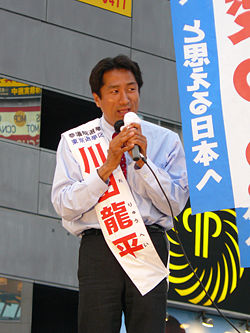
Japanese politician Ryuhei Kawada campaigning in elections to the upper house of the Japanese parliament in 2007; Japan is a democracy where both party-affiliates and independents such as Kawada can successfully seek office. |
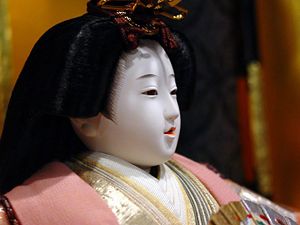
A traditional Japanese doll. The Hina Matsuri (雛祭り 'Doll Festival') is held every 3rd March in Japan.
|
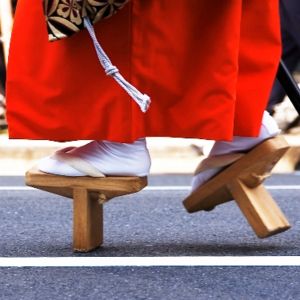
|
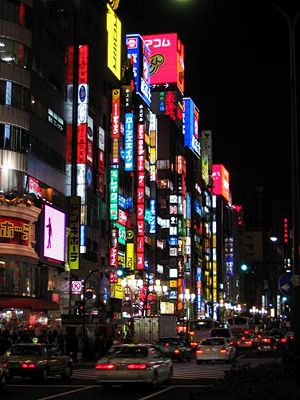
|
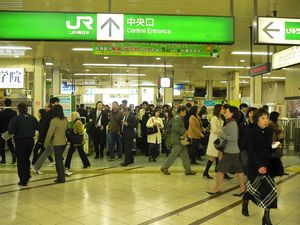
Tokyo Station commuters.
| |
| Return to Japan |
